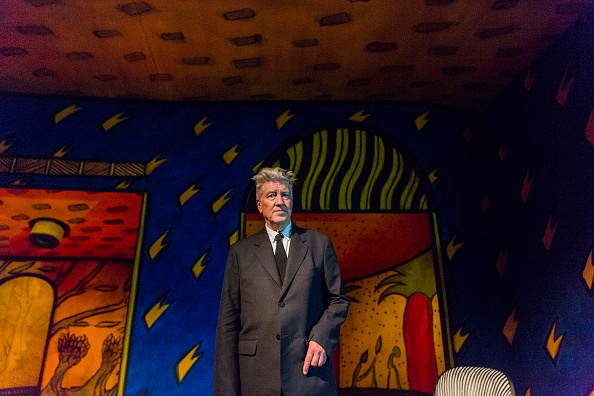With the news of David Lynch’s passing at age 78 come the inevitable—and well-deserved—tributes. The Atlantic called him America’s Cinematic Poet. The New York Times quickly put together a search-optimized list of where to stream “David Lynch Movies and TV Shows.” Hollywood mourned freeheartedly, with everyone from Ben Stiller and Adam Scott to Steven Spielberg and Nicolas Cage sharing their thoughts, tributes and remembrances that reference sometimes surreal and enigmatic works like Eraserhead (1977), The Elephant Man (1980), Blue Velvet (1986), Lost Highway (1997) and Inland Empire (2006). If you’re unfamiliar with those titles but of a certain age, Lynch’s death likely brought to mind Twin Peaks, which, as Observer’s Laura Babiak rightly points out, ushered in a new kind of television that paved the way for shows like Lost and Mr. Robot.
Less well known to many is the fact that David Lynch was a painter and sometimes sculptor represented, beginning in 2022, by Pace. Like many other Hollywood notables, he was an artist first, having studied painting at the Boston Museum School and the Pennsylvania Academy of Fine Arts in the 1960s. It was during this period that he made his first short film, Six Men Getting Sick (Six Times)—an early sign that his instincts were never confined to a single medium. A devoted admirer of Francis Bacon, Lynch continued making art throughout his career, exhibiting paintings, sculpture, prints and mixed-media works informed by Surrealism and Art Brut around the world. His usually unsettling paintings, in particular, are often thick with raw textures, distorted figures and a sometimes queasy, distinctly Lynchian blend of the grotesque and the mundane.
Helen Holmes, covering a solo exhibition at New York City’s Sperone Westwater for Observer in 2019, wrote that David Lynch’s paintings “point towards some of the themes that have made his movies such enduring classics. Vague dissociation, carnage and the creep of filth are all present in works like Billy Sings the Tune for the Death Row Shuffle and Billy (And His Friends) Did Find Sally in the Tree.”
Though his work was exhibited extensively—at the Fondation Cartier in Paris, the Bonnefantenmuseum in Maastricht, Queensland Art Gallery in Australia, Garage Center for Contemporary Culture in Moscow, and at Castelli, Jack Tilton Gallery and Pace—and can be found in the collections of MoMA, LACMA and Fondation Louis Vuitton, it was nothing if not polarizing, reliably provoking strong opinions. He had a knack for pulling viewers into a world where dreams, reality and imagination tangled together, warping perception and sparking introspection, though the work itself was never particularly polished. Ken Johnson, writing for the New York Times in 2024, questioned the impact of Lynch’s visual art compared to his films, asking, “Is Mr. Lynch as compelling a fine artist as he has been a filmmaker?” and answering, “The short answer is no.” In contrast, David Pagel offered a more nuanced view in the Los Angeles Times four years later, stating that Lynch’s paintings “reveal insecurities of adolescence and maligned misfits,” suggesting a depth and complexity that mirrored themes explored in his films.
I found one especially to-the-point review by a fan on an old Twin Peaks message board: “I can tell you digital copies you can see on the Internet don’t do them justice. You have to be there, in front of them, to really appreciate how outright disturbing they are.”
Of course, there are the inevitable claims that the attention his artwork received was just crossover credit—an obligatory nod to celebrity rather than a genuine assessment of talent. But considering his obsessive dedication to making the interior exterior—by all accounts, he was a deeply thoughtful and compulsively prolific filmmaker, painter, actor, and musician—it’s hard to argue that adulation was his endgame when he picked up a brush. Love his paintings, hate his paintings or feel nothing at all about them; provocation wasn’t the point. He had ideas, and he did what artists do: he put them into the world.
In one interview for Purple Magazine, the artist Alex Israel asked Lynch if the figures in his paintings “that have very long arms also express longing, striving, and reaching?” Lynch replied: “Yeah. It’s nice that you say that. There’s a watercolor called Man Reaching, and some lithographs, Reaching out for Nothing, Reaching Out and Reaching. I don’t really think about things so precisely, but ideas come. Ideas are interesting to think about in terms of what makes them come along, and, in my case, in terms of what makes me fall in love with certain ideas and not others…”
As part of a remembrance distributed by Pace, CEO Marc Glimcher wrote that Lynch “turned insanity into philosophy.” But to me, insanity doesn’t feel like the right word. Instead, let me point you back to Holmes, who wrote, “His painted ‘dreams’ aren’t escapist but rather deeply visceral, just like the confusing times we live in.” As within, so without—for those brave enough, like Lynch, to plumb the depths.

